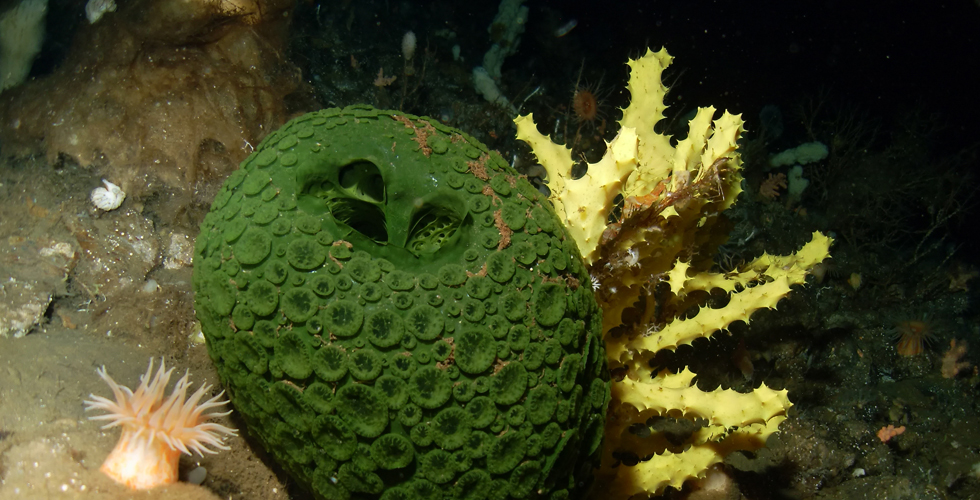Secrets of the Sponge Revealed

Consider the sponge. Call it a lowly, primitive creature and some sponge experts will tell you that you are wrong. These immobile, squishy animals are perhaps better described as simple -- so simple, in fact, that they were long thought to be plants.
With no muscle, no brain, no bloodstream, and no digestive system, the only moving parts of a sponge are tiny flagella that push water through their pores and allow them to soak in nutrients. That simple ability has made sponges the ultimate survivors in the animal kingdom. They live in just about every watery environment in the world, from the deepest oceans to the dingiest fresh-water mud flats, and they have survived every great mass animal extinction in the last several hundred million years.
Now a group of researchers in the United States, Australia, and Germany has squeezed the genetic secrets from one species of modern-day sponge. Their analysis reveals a surprising complexity to the creature and a surprising number of genes that it shares with humans. These discoveries shed light on the evolution of animals in general and may help uncover some of the inner workings of human cancer.
"We can actually infer something about the last common ancestor of all animals," said Mansi Srivastava, a researcher at the Whitehead Institute for Biomedical Research, in Cambridge, Mass.,who conducted the research as part of her doctoral work at the University of California, Berkeley.
Earliest Animal May Have Been Sponge-Like
If sponges are simple on the surface, there is something evolutionarily profound in that simplicity, according to University of Munich molecular paleobiologist Gert Woerheide, who has studied the creatures for nearly two decades but was not directly involved in the research.
"Sponges are everywhere," said Woerheide. "Some of them have been completely unchanged for millions of years."
They occupy one of the earliest-known branches of the animal tree of life. Like all animals, they are descendents of a primordial creature that lived about 750 million years ago and may have been itself sponge-like.
Under the surface, the sponge is somewhat more sophisticated than its simple appearance would suggest, but until the complete sponge genome was announced today, few appreciated just how sophisticated it is genetically.
"The genome is incredibly complex compared to what people expected," said marine biologist Adam Reitzel, who was not involved in the research but studies the genes and evolution of sea anemones and other creatures at Woods Hole Oceanographic Institution in Massachusetts.
According to the new study, which was based on a species of sponge found on the Great Barrier Reef off the coast of Australia, the creature has some 18,000 genes. This is fewer than the number of genes humans possess (currently estimated at about 20,500 genes) -- but not far off. A few years ago, many scientists would have been surprised to find such a diverse set of genes in such a simple creature, said Srivastava.
What is most surprising now, Srivastava added, is just how many genes they have identified in the sponge that are similar to human genes that operate in the body's muscles and the brain's synapses. It is not known what these genes do in sponges, but because the creatures have neither muscles nor brains, it's safe to say that the genes never played the same role they do in humans.
What is an Animal?
Sponges are the least animal-like of all the animals, said zoologist Peter Holland of the University of Oxford, who was not involved in the research.
"So this gives us the first opportunity to truly define ‘what an animal is’, in terms of genes," he said. "And the authors have done that very nicely."
The existence of so many overlapping genes points to what may be a common genetic toolkit that all modern animals, including humans, share and that were inherited from some primordial, ancestor organism.
"It looks like a lot of the inventions -- the genes responsible for making animals animals -- evolved in the common ancestor," said John Finnerty, a marine biologist at Boston University in Massachusetts, who was not involved in the research.
But if sponges, the simplest and most ancient descendents of this ancient ancestor, have so many genes, said Srivastava, this begs the question:What gives rise to the complexity of higher animals?
In their paper, published Wednesday in the journal Nature, Srivastava and her colleagues put forth a hypothesis. By comparing similar gene families across increasingly more complex organisms—such as the sponge, sea anemone, fruit fly, and human—they were able to identify the gene families that have more genes in more complex animals.
The genes an organism has in its genome are analogous to tools in a toolbox, Finnerty explained. To build something new, you may need a new tool -- a specialized hammer, wrench, or screwdriver -- or you may be able to use the tools you already possess in a new way.
The fact that sponges share so many genes with more complex animals reveals a lot about animal evolution, said Finnerty. "Evolution found to a way to generate greater complexity mainly by using existing tools in a new way or by making slight changes to existing tools rather than inventing entirely new kinds of tools," he said.
Now that they know the genes, scientists can attempt to understand what these genes do. A lot of the genes we share with the sponge are involved in human cancer, and the analysis may also help reveal how the genes operate and go awry in human cancer.

